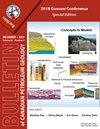Allostratigraphy and paleogeography of the Harmon and Cadotte members of the Peace River Formation (Middle Albian), west-central Alberta and adjacent British Columbia
Q3 Earth and Planetary Sciences
引用次数: 8
Abstract
Abstract The mudstone-dominated Harmon and sandstone-dominated Cadotte members of the Peace River Formation were deposited during the middle Albian in the southern end of a Boreal marine embayment that occupied the foredeep of the Western Canada Foreland Basin. Sandstone of the Cadotte Member represents a shoreface environment and has traditionally been interpreted as the updip equivalent of offshore Harmon mudstone. Allostratigraphic correlation, based on marine flooding surfaces and unconformities shows that the Harmon alloformation can be divided into five regionally-mappable allomembers. Similar erosion surfaces allow the Cadotte alloformation to be divided into three allomembers. The new allostratigraphy shows that the informal Harmon and Cadotte alloformations do not have an interfingering relationship and hence are not genetically related. Harmon and Cadotte allomembers have been mapped over about 100 000 km2, but show no evidence of stratal lap-out or depositional topography; it is concluded that deposition took place on a shallow marine ramp of very low relief. The vertical stacking of Harmon and Cadotte allomembers across the foredeep indicates that rates of accommodation and sediment supply remained in approximate equilibrium throughout deposition of these units. In the far southern and eastern parts of the study area, changing gamma ray log response suggests that marine deposits of both the Harmon and Cadotte alloformations grade laterally into coeval coastal plain deposits that are mapped in outcrop as Gates Formation whereas in subsurface wireline log picks, these rocks are usually included in the Upper Mannville Group. The lateral boundary between offshore mudstone and coeval nearshore muddy sandstone can be mapped within individual Harmon allomembers; the mudstone to sandstone boundary has a lobate to cuspate pattern in plan view, suggesting that, at the southern extremity of the ‘Harmon Sea’ rivers built elongate deltas in a very shallow-water, low wave-energy setting. Lenticular, sharp-based sandstone bodies 17–42 m thick hang from allomember bounding surfaces in both the Harmon and Cadotte alloformations; these sandbodies probably represent paleovalley fills. Valley incision may have been linked to relative sea-level changes that also gave rise to the marine transgressive surfaces that are traceable over the entire study area. In the east, both the Cadotte and Harmon alloformations are completely truncated by a bevelling unconformity at the base of the Paddy and the laterally-contiguous Joli Fou alloformation.阿尔伯塔省中西部和邻近的不列颠哥伦比亚省和平河组哈蒙和卡多特组的古地层学和古地理
和平河组以泥岩为主的Harmon组和以砂岩为主的Cadotte组沉积于阿尔比统中期,位于占据加拿大西部前陆盆地前深的北方海相海湾南端。Cadotte成员的砂岩代表了一个滨面环境,传统上被解释为相当于海上哈蒙泥岩的上倾。基于海相泛面和不整合面进行的异地层对比表明,哈蒙异地层可划分为5个区域可填图的异地层段。类似的侵蚀面使得卡多特异体被划分为三个异体。新的异源地层学表明,非正式的哈蒙异源和卡多特异源没有相互作用的关系,因此没有遗传上的联系。哈蒙和卡多特同素组已在大约10万平方公里的范围内绘制了地图,但没有显示出地层剥落或沉积地形的证据;因此,沉积发生在地势很低的浅海斜坡上。哈蒙组和卡多特组在前深的垂直堆积表明,在这些单元的沉积过程中,调节速率和沉积物供应保持在近似平衡状态。在研究区最南部和最东部,伽马测井响应的变化表明,哈蒙和卡多特构造的海相沉积侧向演化为同时期的海岸平原沉积,在露头上被标为盖茨组,而在地下电缆测井采集中,这些岩石通常被包括在上曼维尔组中。海相泥岩与同时期近岸泥质砂岩的横向边界可以在哈蒙组的各个单元内绘出;从平面上看,泥岩和砂岩的边界呈叶状到尖状,表明在哈蒙海的南端,河流在一个非常浅、低波能的环境中形成了细长的三角洲。在哈蒙和卡多特构造中,17-42 m厚的透镜状、尖状砂岩体悬挂在同种异体的边界面上;这些砂体可能代表古山谷填充物。山谷切割可能与相对海平面变化有关,海平面变化也导致了整个研究区域可追溯的海侵面。在东部,卡多特(Cadotte)和哈蒙(Harmon)构造完全被帕迪(Paddy)底部的斜面不整合面和横向相邻的乔利福(Joli fu)构造截断。
本文章由计算机程序翻译,如有差异,请以英文原文为准。
求助全文
约1分钟内获得全文
求助全文
来源期刊

Bullentin of Canadian Petroleum Geology
Earth and Planetary Sciences-Geochemistry and Petrology
CiteScore
2.50
自引率
0.00%
发文量
0
期刊介绍:
The Bulletin of Canadian Petroleum Geology is a peer-reviewed scientific journal published four times a year. Founded in 1953, the BCPG aims to be the journal of record for papers dealing with all aspects of petroleum geology, broadly conceived, with a particularly (though not exclusively) Canadian focus. International submissions are encouraged, especially where a connection can be made to Canadian examples.
 求助内容:
求助内容: 应助结果提醒方式:
应助结果提醒方式:


